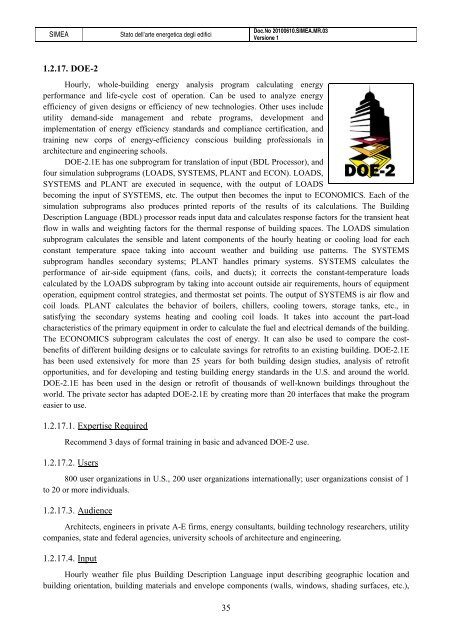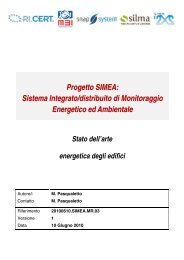Progetto SIMEA - Automatica - Università degli Studi di Padova
Progetto SIMEA - Automatica - Università degli Studi di Padova
Progetto SIMEA - Automatica - Università degli Studi di Padova
You also want an ePaper? Increase the reach of your titles
YUMPU automatically turns print PDFs into web optimized ePapers that Google loves.
<strong>SIMEA</strong> Stato dell’arte energetica <strong>degli</strong> e<strong>di</strong>fici<br />
1.2.17. DOE-2<br />
35<br />
Doc.No 20100610.<strong>SIMEA</strong>.MR.03<br />
Versione 1<br />
Hourly, whole-buil<strong>di</strong>ng energy analysis program calculating energy<br />
performance and life-cycle cost of operation. Can be used to analyze energy<br />
efficiency of given designs or efficiency of new technologies. Other uses include<br />
utility demand-side management and rebate programs, development and<br />
implementation of energy efficiency standards and compliance certification, and<br />
training new corps of energy-efficiency conscious buil<strong>di</strong>ng professionals in<br />
architecture and engineering schools.<br />
DOE-2.1E has one subprogram for translation of input (BDL Processor), and<br />
four simulation subprograms (LOADS, SYSTEMS, PLANT and ECON). LOADS,<br />
SYSTEMS and PLANT are executed in sequence, with the output of LOADS<br />
becoming the input of SYSTEMS, etc. The output then becomes the input to ECONOMICS. Each of the<br />
simulation subprograms also produces printed reports of the results of its calculations. The Buil<strong>di</strong>ng<br />
Description Language (BDL) processor reads input data and calculates response factors for the transient heat<br />
flow in walls and weighting factors for the thermal response of buil<strong>di</strong>ng spaces. The LOADS simulation<br />
subprogram calculates the sensible and latent components of the hourly heating or cooling load for each<br />
constant temperature space taking into account weather and buil<strong>di</strong>ng use patterns. The SYSTEMS<br />
subprogram handles secondary systems; PLANT handles primary systems. SYSTEMS calculates the<br />
performance of air-side equipment (fans, coils, and ducts); it corrects the constant-temperature loads<br />
calculated by the LOADS subprogram by taking into account outside air requirements, hours of equipment<br />
operation, equipment control strategies, and thermostat set points. The output of SYSTEMS is air flow and<br />
coil loads. PLANT calculates the behavior of boilers, chillers, cooling towers, storage tanks, etc., in<br />
satisfying the secondary systems heating and cooling coil loads. It takes into account the part-load<br />
characteristics of the primary equipment in order to calculate the fuel and electrical demands of the buil<strong>di</strong>ng.<br />
The ECONOMICS subprogram calculates the cost of energy. It can also be used to compare the cost-<br />
benefits of <strong>di</strong>fferent buil<strong>di</strong>ng designs or to calculate savings for retrofits to an existing buil<strong>di</strong>ng. DOE-2.1E<br />
has been used extensively for more than 25 years for both buil<strong>di</strong>ng design stu<strong>di</strong>es, analysis of retrofit<br />
opportunities, and for developing and testing buil<strong>di</strong>ng energy standards in the U.S. and around the world.<br />
DOE-2.1E has been used in the design or retrofit of thousands of well-known buil<strong>di</strong>ngs throughout the<br />
world. The private sector has adapted DOE-2.1E by creating more than 20 interfaces that make the program<br />
easier to use.<br />
1.2.17.1. Expertise Required<br />
Recommend 3 days of formal training in basic and advanced DOE-2 use.<br />
1.2.17.2. Users<br />
800 user organizations in U.S., 200 user organizations internationally; user organizations consist of 1<br />
to 20 or more in<strong>di</strong>viduals.<br />
1.2.17.3. Au<strong>di</strong>ence<br />
Architects, engineers in private A-E firms, energy consultants, buil<strong>di</strong>ng technology researchers, utility<br />
companies, state and federal agencies, university schools of architecture and engineering.<br />
1.2.17.4. Input<br />
Hourly weather file plus Buil<strong>di</strong>ng Description Language input describing geographic location and<br />
buil<strong>di</strong>ng orientation, buil<strong>di</strong>ng materials and envelope components (walls, windows, sha<strong>di</strong>ng surfaces, etc.),
















